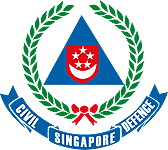Singapore Civil Defence Force
|
Pasukan Pertahanan Awam Singapura சிங்கப்பூர் குடிமைத் தற்காப்புப் படை 新加坡民防部队 | |
|
Crest of the Singapore Civil Defence Force | |
| Agency overview | |
|---|---|
| Formed | 1982 |
| Preceding agency |
|
| Jurisdiction | Government of Singapore |
| Headquarters | 91 Ubi Ave 4, Singapore |
| Employees | 6,000 |
| Minister responsible | |
| Agency executives |
|
| Parent agency | Ministry of Home Affairs |
| Website |
www |
The Singapore Civil Defence Force (abbreviation: SCDF; Malay: Pasukan Pertahanan Awam Singapura; Chinese: 新加坡民防部队; Tamil: சிங்கப்பூர் குடிமைத் தற்காப்புப் படை) is the main agency in charge of the provision of emergency services in Singapore during peacetime and emergency.
A uniformed organisation under the purview of the Ministry of Home Affairs, the main role of SCDF is to provide fire-fighting, rescue and emergency ambulance services; mitigating hazardous materials incidents, as well as formulate, implement and enforce regulations on fire safety and civil defence shelter matters.[2] It also plays a major role in the Republic's disaster relief operations. SCDF was classified as a heavy urban search and rescue (USAR) team by INSARAG on 18 January 2009, the highest level possible for any USAR team.[3]
History

As early as 1855, Singapore's first Fire Committee was formed after a fire in Kling Street destroyed S$13,000 worth of property on 7 November 1855. Prior to this, fires were attended to by uniformed groups which included the police, sepoys, marine soldiers and even convicts. On 7 September 1869, the Governor Major-General Sir Harry St. George Ord enacted the Fire Ordinance and appointed the Colonial Engineer as Chairman of the Fire Commission for Singapore. In 1888, the Singapore Fire Brigade was established and with sufficient funding, gained recognition as a fully equipped professional brigade. By 1909, there were a total of three built stations servicing Singapore, namely Central Fire Station at Hill Street, Cross Street and Kallang Fire Stations.[4]
Over the early years of independence, the Singapore Fire Brigade faced several major incidents, such as the Bukit Ho Swee Fire of 1961, the Robinson Fire of 1972, and the Spyros explosion and fire of 1978. In 1980, the Singapore Fire Service (SFS) became the official name for the brigade. In 1982, the National Civil Defence Plan was launched which spearheaded the emergency preparedness for the nation. With the enactment of the Civil Defence Act in 1986, the SCDF was established as an independent organisation under the Ministry of Home Affairs (MHA). In the same year, the Hotel New World disaster paved the way for joint operations between the SCDF and Singapore Fire Service (SFS). Due to the similarity in roles and functions, the SCDF and SFS were formally integrated on 15 April 1989.[5]
The newly integrated SCDF mainly used facilities which were handed over from the Singapore Armed Forces or the Singapore Police Force. Since the early 2000s, its headquarters and territorial divisions have all moved into purpose-built facilities. SCDF's involvement in regional disaster relief operations has also raised its profile significantly.
Organisation structure
The SCDF is branched into seven Operational and Training Divisions beneath the Headquarters Element. Of these, four are Territorial Divisions, each covering a section of Singapore corresponding roughly to the four cardinal points of the compass. Each division possesses its own bunkered and mobile Command Centres, Hazmat response capabilities, as well as full internal administration structures.
The two core training establishments, namely the Civil Defence Academy (CDA) and National Service Training Institute (NSTI), while not covering any territory or have any primarily operational concerns, are recognised as divisions unto themselves with full administration, supply and support units. These units become operationally active as the 5th and 6th SCDF Divisions respectively in times of emergency or war.
Since 1 April 2012, the SCDF Marine Command (SCDF MC) has been set up and possesses the capability and capacity to respond to marine fire and rescue incidents.
Headquarters
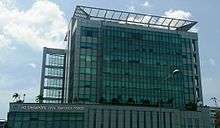
The Headquarters complex of SCDF contains the Command Centre for all operations nationwide. It is co-located with the DART (Disaster Assistance and Rescue Team) Base, Central Supply Base and Paya Lebar Fire Station in a secured compound on Ubi Avenue 4. In addition to command and control, logistics, and operational facilities, HQ SCDF is also made up of an administration structure consisting of numerous staff departments. These staff departments, listed below, co-ordinate and carry out the administration of various key aspects of the force, under the command of the Commissioners and Department Directors.
- Operations Department
- Hazardous Materials Department
- Strategic Planning Department
- Medical Department
- Training Department
- Service Excellence Department
- Technology Department
- Logistics Department
- Finance Department
- Public Affairs Department
- Volunteer and Community Partnership Department
- Manpower Department
- National Service Personnel Department
- Fire Safety and Shelter Department
- Central Enforcement Department
Operational divisions
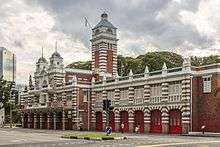
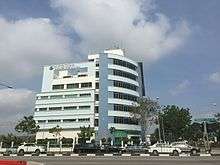
- The 1st Division oversees operations in the general south of Singapore, stretching from Clementi to the Central Business District (CBD). It also oversees Jurong Island, an important oil refining centre. The division headquarters is located at Queensway, behind Alexandra Hospital, together with the Queenstown Neighbourhood Police Centre and Alexandra Fire Station.
- Fire Stations: Central, Alexandra, Clementi, Jurong Island, Bishan, Banyan, Marina Bay, Sentosa
- The 2nd Division oversees operations in the east of Singapore, including Paya Lebar, where the HQ complex is located, as well as Changi Airport. The headquarters are located in Tampines, co-located with the Tampines Fire Station.
- Fire Stations: Paya Lebar, Changi, Tampines
- The 3rd Division covers the northern segment of Singapore, and is headquartered at Yishun together with Yishun Fire Station.
- Fire Stations: Yishun, Ang Mo Kio, Sengkang
- The 4th Division oversees operations in the west of Singapore, and is headquartered at Bukit Batok, together with Bukit Batok Fire Station.
- Fire Stations: Jurong, Tuas, Woodlands, Bukit Batok, Tuas View
- The SCDF Marine Command (SCDF MC) is in charge of marine fire fighting. It is headquartered at Pulau Brani, together with Brani Marine Fire Station.
- Fire Stations: West Coast (Marine), Brani (Marine)
Training divisions
- The Civil Defence Academy (CDA) conducts training courses for various vocations and specialisations, ranging from firefighters to medics to physical training instructors (PTIs) and officers, both senior and junior. Although primarily to prepare recruits freshly graduated from the BRTC for operational duty, the CDA also frequently hosts guest trainees from outside the SCDF, including fire brigades and emergency crews from other nations. While courses such as the International Fire-fighting Course are specially designed and held for these guests, some of these guests trainees train together with Singapore trainees in the Section Commander Course (SCC) and/or Rota Commander Course (RCC), graduating together with NSFs and regulars as either junior specialists or senior officers.
- The National Service Training Institute (NSTI) comprises two centres, the Basic Rescue Training Centre (BRTC) and In-Camp Training Centre. The BRTC trains enlistees, with a new battalion of 3-4 companies passing out every quarter with competency in basic rescue skills as well as an adequate level of fitness. The In-Camp Training Centre trains Operationally Ready NSmen. The NSTI also houses a detention block with razor wire fences installed around the building, as in Singapore Armed Forces military camps.
Both the CDA and NSTI complexes are co-located in Choa Chu Kang, along Jalan Bahar.
Appliances
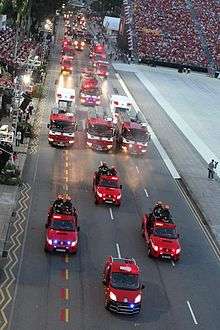

The Singapore Civil Defence Force maintains a large fleet of custom-made vehicles (referred to as appliances) to provide an emergency response force capable of mitigating any and all kinds of fires and disasters. Ranging from the generic fire truck and ambulance, to more sophisticated mobile command structures and disaster mitigation vehicles such as Hazardous Materials (Hazmat) Pods, many of the appliances were designed and commissioned by the Force itself which prides itself in customising its own fleet as opposed to obtaining ready-made designs from industries. This is directed towards improving the Force's response capability towards an increasingly large variety of emergency scenarios and threats, in addition to basic firefighting and paramedical services, particularly in the Singapore context.
The following list of appliances is not exhaustive, and is grouped according to application as well as the order of scale of response capability.
Paramedical response vehicles
- Fast Response Paramedic (FRP)
- Essentially a paramedic on a heavy motorcycle with a small array of portable first aid equipment and tools, the FRP is meant to provide the most rapid form of emergency medical response. This is especially useful when there are traffic jams on roads leading to an incident site which would delay a conventional ambulance.
- Ambulance
- Often referred to as the "Alpha", the white and red SCDF ambulance forms the backbone of Singapore's medical emergency response capability, and is the most widely deployed appliance. Each ambulance is staffed by an ambulance driver, a paramedic, and a medical orderly. Occasionally, a Fire & Rescue Specialist or ERS trainee may also be attached to an ambulance unit.
- SWIFT (Station With Immediate First-aid Treatment)
- The SWIFT is a "Transformer" vehicle, and functions as a mobile hospital. On the roads, it takes the form of a vehicle roughly the size of a small bus, and expands on both sides when it reaches the incident site. When fully deployed, it is capable of treating a large number of patients concurrently on operating tables that slide out beneath its "wings".
- This vehicle is designed for mass-casualty events requiring on-site treatment capabilities and has yet to be used in active service to this date.
Firefighting appliances
- Fire Bike
- SCDF Piaggio MP3 three-wheeler Firebikes affectionately known as the red Scorpions are strategically deployed at 40 locations islandwide providing a prompt response to both fire and medical cases. These Firebikes are able to weave through traffic providing a faster response to emergency incidents.
- Armed with the new backpack Compressed Air Foam, these firebikes are capable of extinguishing fires such as household fire and vehicle fire. Equipped with an Automatic External Defilbrillator (AED) these fire bikes are also deployed for Cardiac arrest cases.
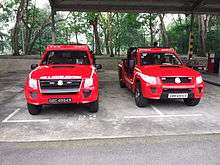
- Light Fire Attack Vehicle (LFAV aka Red Rhino)
- First introduced in 2000, the Light Fire Attack Vehicle (LFAV), or better known as the Red Rhino, was specially designed to be more compact than a traditional fire engine, allowing it to be more agile and able to be deployed closer to the heart of any fire or rescue incident.
- In 2009, the Red Rhino received further design and construction enhancements. The version 2.xx of the Red Rhino, is designed to be smaller and lighter than the original version, allowing better accessibility in tight and narrow spaces.
- In 2016, the 5th version of the LFAV was released, called the LF5G
- The latest version 5 of the Red Rhino features a 3.0L Turbo engine with 4WD, Automatic transmission with automated PTO, 500GPM Pump, 150 litres of foam concentrate tank and 2 x backpack CAF capable of responding to a variety of fire and rescue incidents, and is more agile and compact compared to Gen 1 and 2.
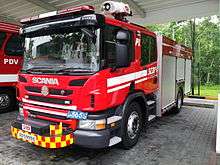
- Pump-Ladder (PL)
- SCDF has a fleet of operational fire engines or Pump-Ladder deployed at every Fire Station. These vehicles are equipped with rescue equipment and fire-fighting accessories. The fire engine has a water tank that can store 2,400 litres of water used for fire-fighting operations and 1,200 litres of foam tank.
- To enhance the decontamination capabilities of the Force, these PLs have been retrofitted with the necessary accessories to set up Hasty Decontamination of casualties in a chemical incident. The decontamination lanes can be set up within four minutes; and each lane is able to decontaminate up to 36 walking casualties or six lying casualties per hour.
- The latest Generation E of the PL features the latest Compressed Air Foam System technology and a dedicated hasty decontamination facility.
- Combined Platform-Ladder (CPL)
- CPL is a hydraulic ladder-platform which is commonly used by fire fighters to conduct external firefighting and rescue operations involving high-rise buildings. There are two main types of CPLs in SCDF - one that reaches up to 32/34 metres (depending on variant) and another that has an operating height of 53m.
- Breathing Apparatus Tender (BAT)
- The BAT is a support appliance which will be deployed for all major incidents to provide the fire-fighting crews with adequate breathing apparatus sets to manage prolonged operations. It is also equipped with Thermal Image Cameras and Gas Detectors to facilitate rescue operations during smoke-logged conditions.
- Damage Control Tender (DCT)
- The DCT is deployed for all major incidents to support the fire-fighting crews with ventilation and water extraction operations. In the DCT are advanced equipment that can expediently blow or extract smoke from smoke-logged areas, or remove water from flooded areas.
- Fire and Rescue Operations Support Tender - FROST (OST)
- The FROST is designed to integrate the features of two existing support vehicles, the Breathing Apparatus Tender and the Damage Control Tender. FROST combines the capabilities of the two and has ventilation equipment, breathing apparatus and search equipment, among other features. It halves the manpower needed to for these functions from eight to four.
- Tracked Firefighting Vehicle (TFV)
- Several Bandvagn 206 (Bv206) were transferred from the Singapore Armed Forces (SAF) to the SCDF, painted in the SCDF colours of red and white, and subsequently fitted with the necessary firefighting equipment and capabilities. The TFV is designed for use in forested areas where wheeled vehicles may have difficulty in reaching.
Hazmat appliances
- Hazmat Mitigation Vehicle
- SCDF’s latest additions to its fleet of Hazmat appliances is the Hazmat Mitigation Vehicle (HMV). The HMV offers a swift and integrated response by accommodating all the HazMat Incident Team members and specialised equipment in one multi-compartment vehicle.
- Another novelty of the HMV is its vehicle-in-vehicle concept, where a Hazmat Utility Buggy (HUB) housed at the rear of the appliance can be quickly unloaded and used to assess incident developments, transport equipment and even convey casualties out of the hazard area. With the HMV, SCDF is able to enhance its monitoring of large area of operations, as well as improve the survivability of the casualties.
- Hazmat Decon Pod
- The Hazmat Decon Pod sucks in contaminated air and purifies it at a high rate to remove atmospheric toxic material and render an area more hospitable for work following a chemical, biological or radiological (CBR) incident.
- Personnel Decontamination Vehicle (PDV)
- The size of a large bus, the PDV is one of the largest operational appliances that the SCDF has. It is the main mode of transport and response of Special Rescue Unit, housed at the four divisions. It is also designed to cater for mass casualty incidents involving (CBR) substances, and is fully equipped to decontaminate, by shower, a large amount of casualties at one go when deployed.
- Outside HazMat incidents, it functions as a troop carrier for the SRB, as well as a super-ambulance capable of evacuating an entire busload of casualties to hospital for treatment.
- Special Decontamination vehicle (SDV)
- The SDV, in addition to performing the function of the Hazmat Decon Pod, also decontaminates the terrain with a large amount of water and carries specialised equipment used by the Special Rescue Unit.
Command elements
- Forward Command Vehicle (FCV)
- The FCV is a larger version of the command post, and is deployed at the division Level. It serves the purpose of a mobile communications and control centre and is deployed during more serious incidents requiring division-level advanced command capabilities.
- Command Vehicle (CV)
- SCDF maintains a fleet of five Command Vehicles, which together function as a mobile headquarters command and control centre. The vehicles are the size of a large bus, and when deployed, the body of the vehicle stretches to thrice its size on the road, allowing ample space inside the vehicle for personnel and essential computer and communications equipment.
- These Command Vehicles are only deployed to strategic locations to provide forward tactical headquarters capability in major incidents or high-risk events, such as the recent IMF-World Bank conference held in Singapore in 2006.
- Hazmat Command Vehicle (HCV)
- The Hazmat Command Vehicle is essentially a Command Post specifically designed for command and control during a CBR incident. It is equipped for this task with a wide array of instruments and sensors which can, for example, monitor and help predict toxic material presence and dispersion in the wind.
Special vehicles
- Heavy Rescue Tender (HRT)
- Like the SRT, the HRT is used primarily by the DART unit, and carries specialised equipment catering to uncommon or major incidents, such as structural collapses and underwater rescue. The special equipment is carried in mobular containers which can be interchanged to suit the operation before being deployed, and the vehicle possesses a crane as well.
Operation Lionheart
SCDF maintains a rescue contingent on 24-hour standby under the codename Operation Lionheart to provide rescue and humanitarian assistance and support to countries stricken by major disasters. Since its formation in 1990, the Operation Lionheart contingent had responded to 16 overseas missions.[6]
Below is the breakdown of the missions:
| Disaster | Country | Year |
|---|---|---|
| Baguio City Earthquake | Baguio City, Philippines | Jul 1990 |
| Highland Towers Collapse | Kuala Lumpur, Malaysia | Dec 1993 |
| Tai Chung County Earthquake | Taiwan | Sep 1999 |
| Asian Tsunami Disaster | Aceh, Indonesia | Dec 2004 |
| Asian Tsunami Disaster | Khao Lak, Thailand | Dec 2004 |
| Sumatra Earthquake | Nias Island, Indonesia | Mar 2005 |
| Rokan Hilir Bush Fires | Sumatra, Indonesia | Aug 2005 |
| South Asian Earthquake | Muzaffarabad, Pakistan | Oct 2005 |
| Central Java Earthquake | Central Java, Indonesia | May 2006 |
| Sichuan Earthquake | Sichuan, China | May 2008 |
| Padang City Earthquake | Sumatra, Indonesia | Oct 2009 |
| Christchurch Earthquake | Christchurch, New Zealand | Mar 2011 |
| Japan Earthquake | Soma City, Japan | Mar 2011 |
| Malaysia, Flood | Kelantan, Malaysia | Dec 2014 |
| Thailand, Forest Fire | Chiang Mai, Thailand | Mar 2015 |
| Nepal Earthquake | Kathmandu, Nepal | May 2015 |
Ranks and badges
Ranks
These ranks feature the following charges:
- Chevrons — a V-shaped marking
- Curved Bar — a U-shaped marking
- Pips — Four-sided starbursts with the crescent and stars from the National Arms of Singapore at the centre
- National Arms — The National Arms of Singapore when used as a rank insignia is rendered differently from its original depiction. The rank version of the National Arms still depicts the lion, tiger and the shield with the crescent & five stars. However, the rank version of the National Arms replaces the original water spurts with palm laurels and does away with the motto-scroll bearing "Majulah Singapura"
- Commissioner's Badge — Two axes in saltire within laurels
The ranks are displayed here in descending order from highest seniority at the top to lowest at the bottom.
Commissioners
- Commissioner — Commissioner's Badge, topped with a pip and the National Arms, in that order
- (DC) Deputy Commissioner — Commissioner's Badge, topped with the National Arms
- (SAC) Senior Assistant Commissioner — Commissioner's Badge, topped with two pips
- (AC) Assistant Commissioner — Commissioner's Badge, topped with a pip
Commissioned Officers (Senior Officers)
- (COL) Colonel — three National Arms
- (LTC) Lieutenant-Colonel — two National Arms
- (MAJ) Major — one National Arms
- (CPT) Captain — three pips
- (LTA) Lieutenant — two pips
Warrant Officers
- (SWO) 1st Senior Warrant Officer — National Arms enclosed by a curved bar below and four inverted chevrons above
- (SWO2) 2nd Senior Warrant Officer — National Arms enclosed by a curved bar below and three inverted chevrons above
- (WO1) 1st Warrant Officer — National Arms enclosed by a curved bar below and two inverted chevrons above
- (WO2) 2nd Warrant Officer — National Arms enclosed by a curved bar below and an inverted chevron above
Specialists (Junior Officers)
- (SSG) Staff Sergeant — three chevrons topped with the National Arms
- (SGT) Sergeant — three chevrons
Section Commander Course & Rota Commander Course
- (OCT) Senior RCC — two horizontal bars
- (OCT) Junior RCC — one horizontal bar
- (SCT) Senior SCC — two inverted chevrons
- (SCT) Junior SCC — one inverted chevron
Non-Commissioned Officers
- (CPL) Corporal — two chevrons
- (LCP) Lance Corporal — one chevron
- (PTE) Private — no insignia
- (REC) Recruit — no insignia
Badges
- Fire Badge
- Paracounsellor Badge
- Paramedic Badge
- Medical Orderly Badge
- Civil Defence Triangle 
The above badges are worn above the left breast pocket, higher up from service medals or ribbons, and typically identify personnel with major specialist training and/or experience. As there are a number of SCDF officers who were from SAF, these officers continue to don their SAF service medals or ribbons.
Specialist tabs
- DART Tab
- K9 Search Tab
- Paramedic Tab
- Trauma Paramedic Tab
- Hazmat Tab
- CBRE Tab
- Fire Investigation Tab
- Marine Tab
- Emergency Medical Technician(EMT)
These specialist tabs bearing the titles are worn on the uniform top left sleeve. Gold and Silver Individual Physical Proficiency Test (IPPT) Badges that signify personnel with outstanding physical proficiency are worn on the left sleeve, beneath any Specialist title decorations.
In popular culture
Fictional television programs:
- Fiery Passion (烈焰焚情), 12 February 1992
- On the Frontline (穿梭生死线), 2000
- Life Line, 2005
- Without Warning 26 October 2006
- Life Line 2, 15 May 2007
- Rescue 995 (九九五), 6 February 2012
See also
- Civil defence by nation
- Civil Defence Auxiliary Unit
- National Service in Singapore
- National Civil Defence Cadet Corps
- SAMU, an equivalent organisation in France
References
- Citations
- ↑ "HQ SCDF - Key Appointment Holders". Retrieved 18 September 2014.
- ↑ SCDF Website - GENERAL: About Us
- ↑ Parliamentary Question Reply on Deployment of Volunteers as Overseas Missions Observers, 11 April 2011
- ↑ Singapore Fire Brigade
- ↑ SCDF Website - GENERAL: Milestones
- ↑ SCDF Website - NEWS: SCDF deploys rescuers to New Zealand
- Bibliography
- Joan Hon (1988). 100 Years of the Singapore Fire Service. Times Books International. ISBN 9971-65-513-6.
